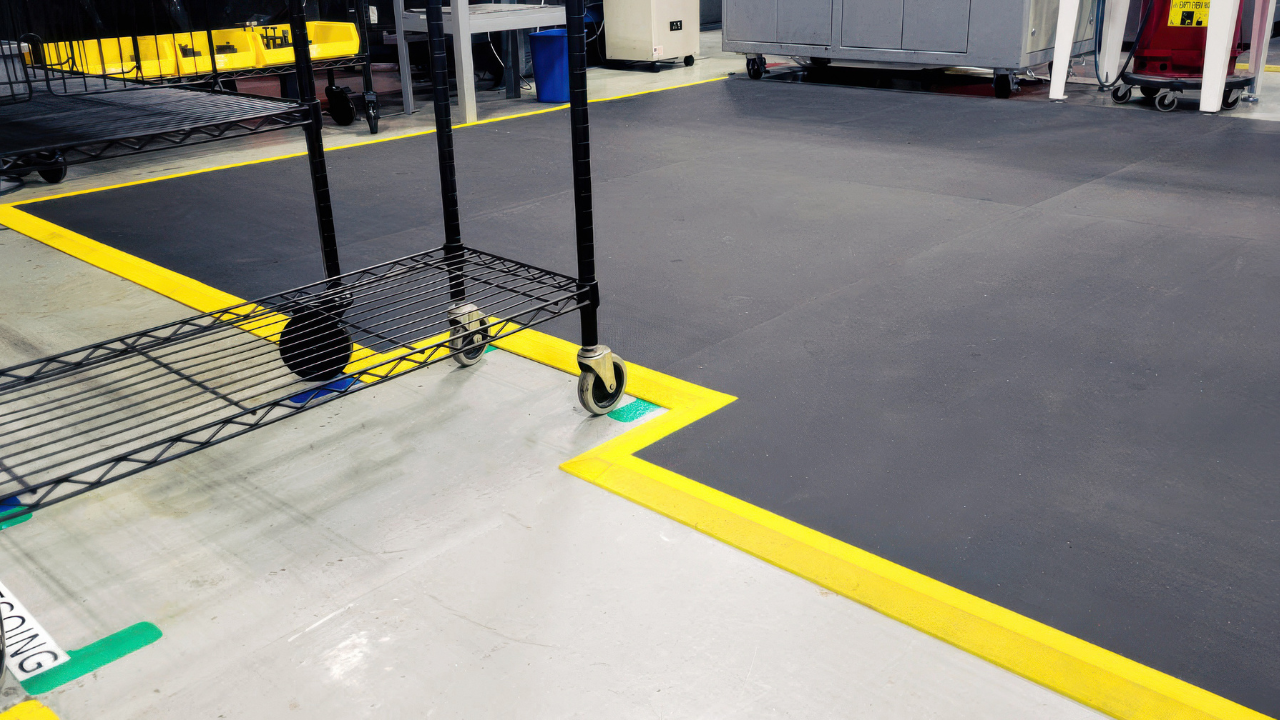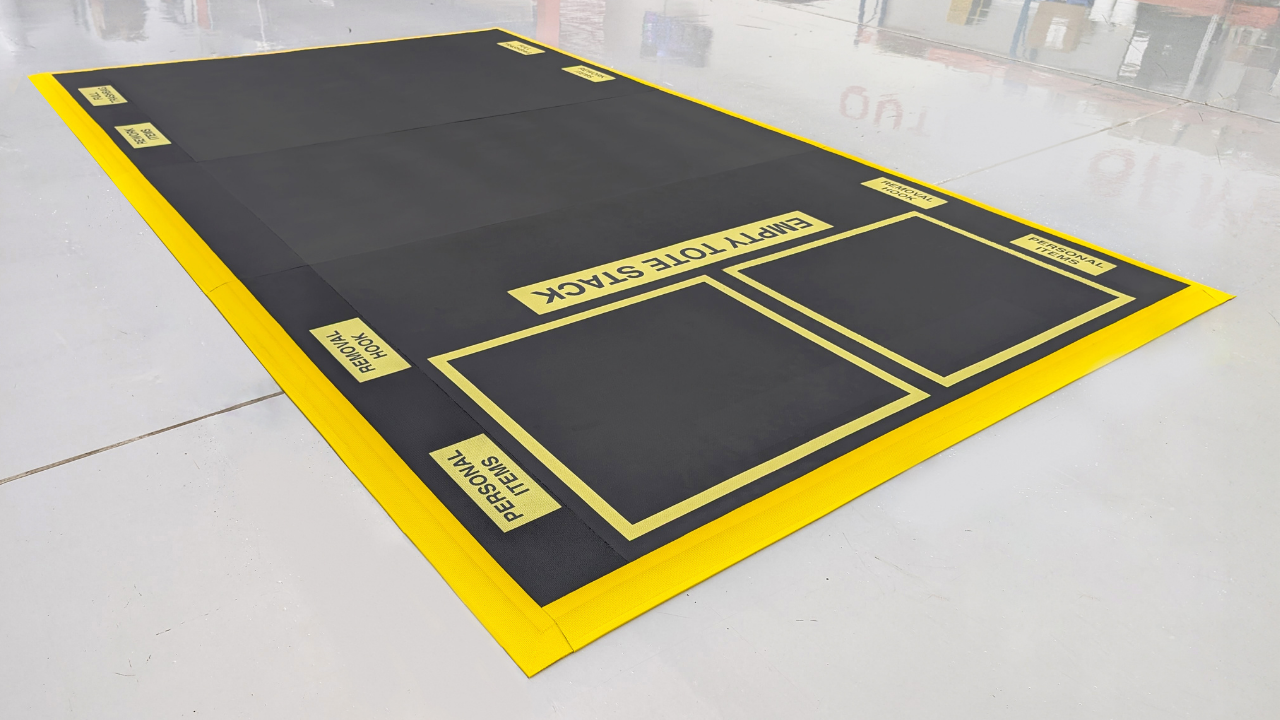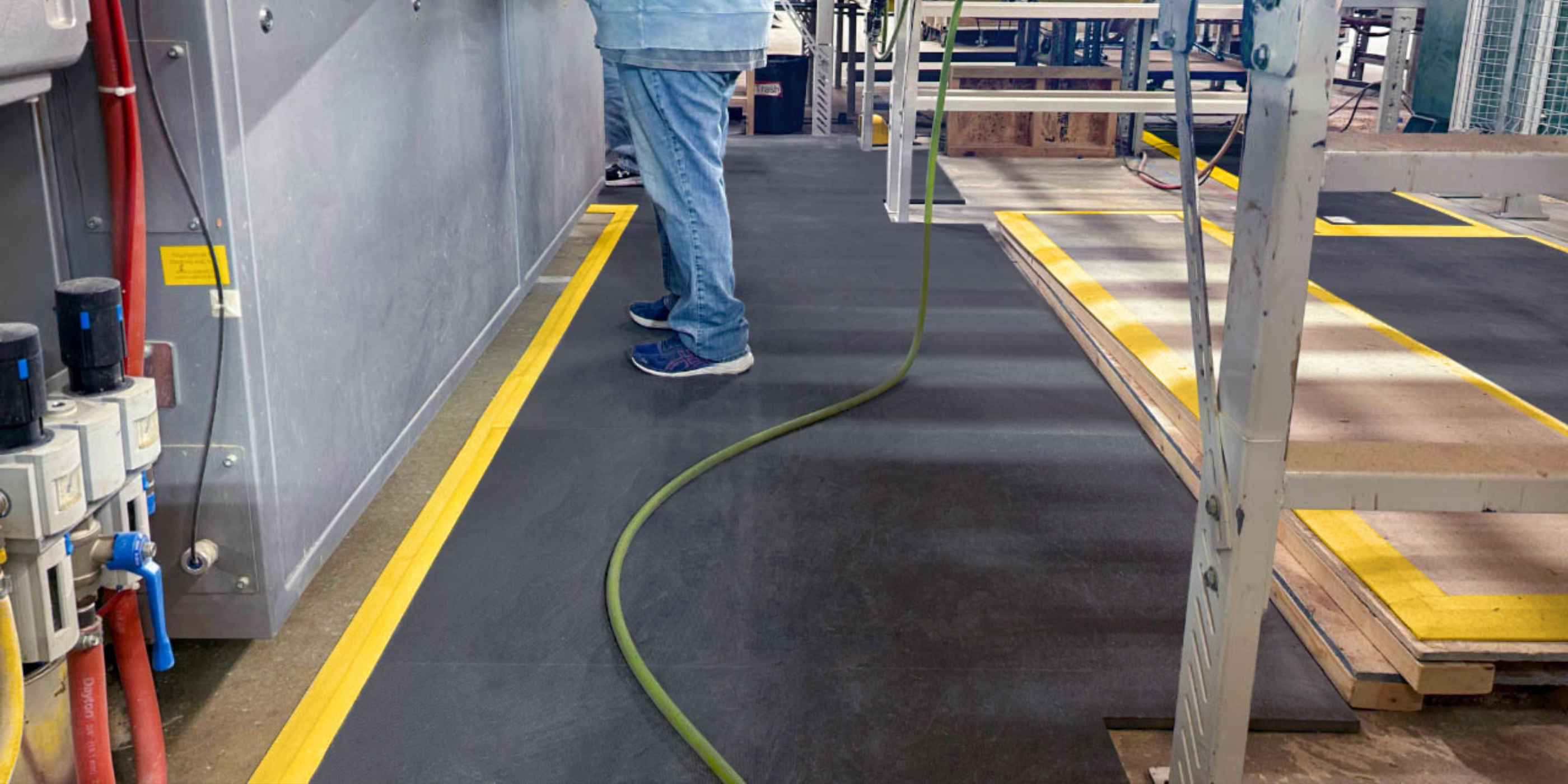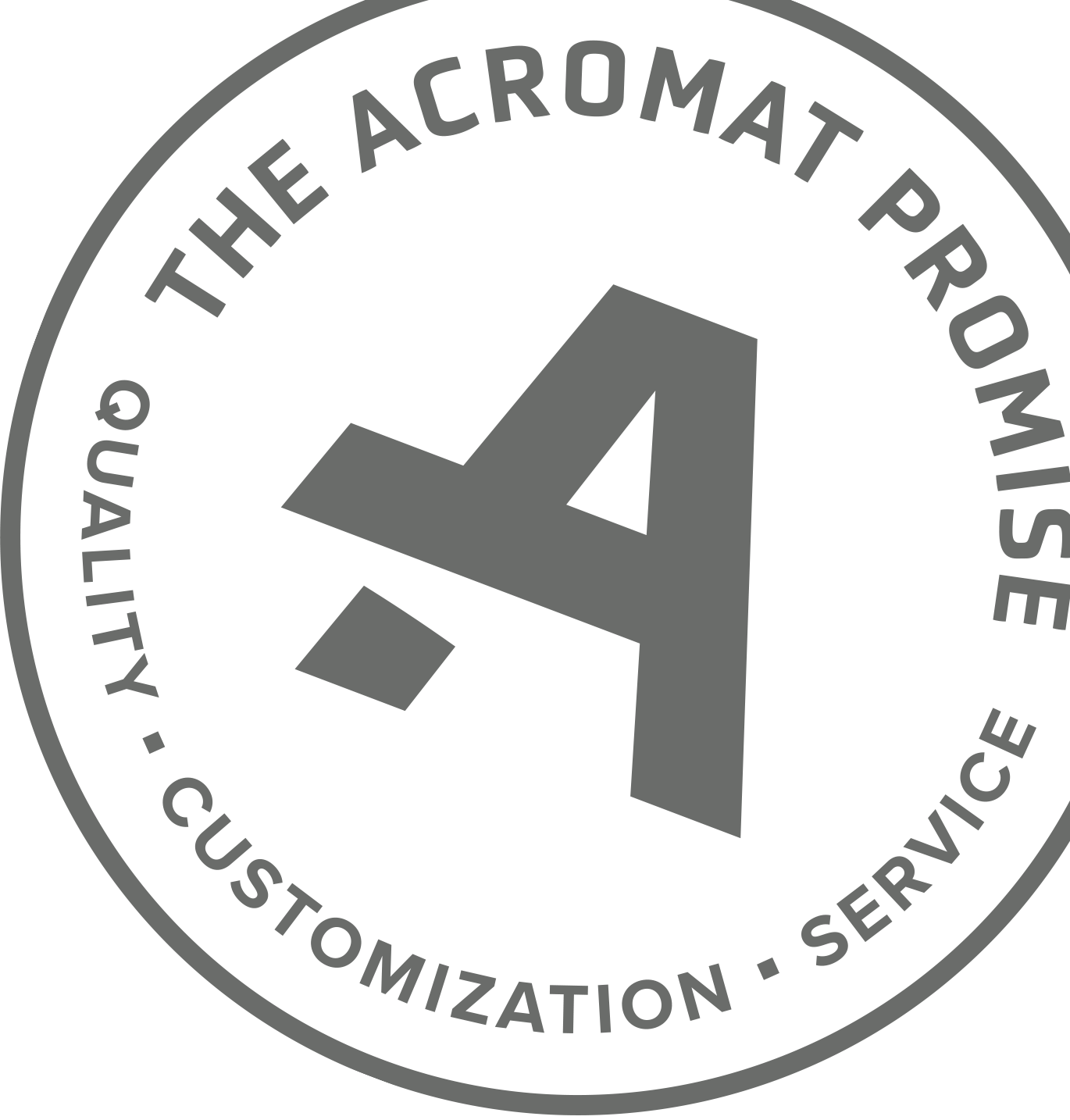Fifty-two percent of manufacturing, safety and production leaders expect their anti-fatigue mats to last at least 2 years. Nearly 70% say they don’t last even a single year. This is perhaps the No. 1 problem with anti-fatigue mats today – they aren’t performing the way your workforce needs them to, or lasting as long as the promotional materials said they would.
This not only impacts the health and safety of your people, but your ability to properly plan and budget. The good news is, there are ways to make sure your anti-fatigue mats last, and it starts with avoiding the most common pitfalls during the research and buying process.
If just getting started or looking to make a change, avoid these 7 common mistakes when buying new anti-fatigue mats:
1. DON’T assume all mats are alike.
PVC foam, PVC/nitrile blends, 100% nitrile – there are a lot of mats and mat materials out there to choose from. Many mats look the same or similar. Assuming they are is one of the most common reasons buyers end up with the wrong mats.
As an example, at AcroMat, we design and manufacture anti-fatigue mats for standing workers primarily in manufacturing settings. These professional stand 8-10 hours per shift, needing ergonomic support without being so soft that it negatively affects posture. Their facilities often operate 24 hours a day, so they also need a material that can endure in harsh environments without breaking down from heavy use.
Based on these needs, we make our mats from molded, closed cell, 100% nitrile rubber foam. This material has proven to be the most valuable for long-standing workers in terms of performance, ergonomic benefit and durability. Conversely, PVC foam mats for manufacturing environments wear down quickly because they're extruded and open cell.
The following chart provides a glimpse:
 Each foam mat material has pros and cons. What's best for you depends on your environment, budget and the goals you're trying to accomplish.
Each foam mat material has pros and cons. What's best for you depends on your environment, budget and the goals you're trying to accomplish.
Related: Get to Know Your Materials: 100% Nitrile vs. PVC Foam
Action step:
Skip the big-box store suppliers and go directly to an anti-fatigue mat manufacturer. Share details about your particular environment, and let them know the type of performance your people need.
Suppliers sell someone else’s anti-fatigue mats; mat manufacturers actually make their mats. Mat manufacturers have direct insight into how their mats perform, access to testing and certifications, and even the ability to hone their building processes.
These are perspectives suppliers and their sales reps simply do not have, and they can give you deeper insight into the right materials for your environment.
 This aerospace manufacturer replaced 35 rectangular, PVC foam mats that were lasting less than a year with a single 1,300 sq. ft. 100% nitrile rubber foam custom mat, now lasting ~5 years without interruption. They previously thought "mats are just mats," leading to durability, safety and budget issues. The change has transformed all of the above.
This aerospace manufacturer replaced 35 rectangular, PVC foam mats that were lasting less than a year with a single 1,300 sq. ft. 100% nitrile rubber foam custom mat, now lasting ~5 years without interruption. They previously thought "mats are just mats," leading to durability, safety and budget issues. The change has transformed all of the above.
 This HVAC manufacturer used PVC foam mats in an oily environment. The open cell materials broke down quickly, leading to erosion, lost traction and no cushion for standing workers.
This HVAC manufacturer used PVC foam mats in an oily environment. The open cell materials broke down quickly, leading to erosion, lost traction and no cushion for standing workers.
2. DON’T skip the sample process
As an anti-fatigue mat manufacturer, we’re thrilled when company leaders visit our website and places an order right away. Immediate sales are great for our business. But we don’t encourage this approach. On our website, leading our sales process and in all of our collateral, we strongly encourage a robust free trial or sample process before you make a purchase.
 Get a free sample mat. Test it for weeks or months in your environment to be certain of durability. Ask the operators who will be using the mat(s) for their thoughts and feedback.
Get a free sample mat. Test it for weeks or months in your environment to be certain of durability. Ask the operators who will be using the mat(s) for their thoughts and feedback.
Conducting a full-scale trial gives you critical insight into durability, comfort (and feedback from the people who will be using the mats), and even benefits like aesthetics. If just getting started with mats, here’s how we recommend proceeding:
I. Get a free full-sized mat to trial.
Hand-sized squares don't give you any valuable information; you need a full-sized mat you and your team members can actually stand on and walk across.
II. Test the mat in production.
Expose the sample mat to the environment you will be using it in. If in search of anti-fatigue mats for a heavy industrial setting, breakrooms and business offices won’t provide valuable insight. Your sample mat needs to face heavy use, chemicals, particles, cart traffic and anything else that might come in contact with the mat on a daily basis.
III. Test it for weeks or months.
Every mat will last a few months. It's how they respond beyond this point that matters most to your team. Don’t let sales representatives rush you; make sure you’ve tested the mat for at least 200 working hours before making any conclusions.
IV. Get feedback from the people using the mats.
I talked to a plant supervisor with a solar panel manufacturer recently who said one of the three sample mats they were trialing was “way more comfortable” than the others. He works mostly from a business office, and was trialing the mat at his desk. During a visit to the production floor, I asked a machine operator who would be using the mats 8-10 hours a day. She said, “The mat is way too soft, my ankles feel like they're sinking.” This type of feedback shouldn't be ignored.
 On the left, a custom 100-1 Series free sample mat AcroMat made for a prospective client. On the right, a box of hand-sized samples the prospect received from other providers. The latter doesn't give you any valuable insight into comfort, durability or performance.
On the left, a custom 100-1 Series free sample mat AcroMat made for a prospective client. On the right, a box of hand-sized samples the prospect received from other providers. The latter doesn't give you any valuable insight into comfort, durability or performance.
Action step:
When we visit client sites for safety assessments, we always start in the same place: We ask the people who use the mats every day. Here are four questions to ask your people during the sample process:
- What would you change about the mat you're currently working on?
- Do you feel safe and physically supported by the mat you’re using?
- How do you feel physically at the end of your shift?
- Do you have any foot, lower limb or back pains you can't connect to an impact injury?
3. DON’T buy and cut long rolls of mat
Buying and cutting rolls of mat may seem “budget-friendly,” but this approach above all others creates health and safety hazards. Cutting rolls of mat to try and fit your workspaces leads to gaps between mats, a lack of beveled edges, and a higher likelihood of sliding. Further, roll mats are mass-produced and made from a low-quality material – likely PVC foam.
 TruStile Doors was previously cutting rolls of mat to fill their workspaces (left and center photos). The gaps caused a rolled ankle, 12 days of missed work, and required physical therapy. According to the EHS Manager, this single injury cost more than the custom mats they needed to fix the problem.
TruStile Doors was previously cutting rolls of mat to fill their workspaces (left and center photos). The gaps caused a rolled ankle, 12 days of missed work, and required physical therapy. According to the EHS Manager, this single injury cost more than the custom mats they needed to fix the problem.
Related: TruStile Doors Overcomes Injury With Custom Anti-Fatigue Mats
Action step:
If you use roll mats, visit the production floor and assess them carefully. Are you seeing gaps between mats? Are haphazard, hand-cut pieces being strewn together? Do the individual pieces easily slide around? Talk to your people, document the issues, and make sure the mats you have in place aren’t actively working against your team.
Our printable Mat Inspection Checklist is a helpful guide to get you started.
4. DON’T settle for “waterfall” designed mats
If your anti-fatigue mats are designed poorly and made from a material that isn’t designed to endure in your facility, they will curl upwards and create trip hazards. One common culprit of curling includes anti-fatigue mats made with the “waterfall” design – the most common approach to diamond-plate anti-fatigue mats.
This approach creates the highest likelihood your mats will curl over time.
 Right photo: Waterfall diamond-plate mat design. Left photo: AcroMat's NitriTuf Diamond Series anti-fatigue mat, made using the cut-and-bond approach.
Right photo: Waterfall diamond-plate mat design. Left photo: AcroMat's NitriTuf Diamond Series anti-fatigue mat, made using the cut-and-bond approach.
Waterfall diamond-plate mat design:
From the right photo above, we visited this helicopter manufacturer in 2024 and the curling “waterfall” runners were everywhere. The company is making an incredibly high-value product, but the people behind the product are navigating a host of trip hazards.
Diamond-plate mats consist of two pieces:
I. A foam pad, which provides the anti-fatigue cushion.
II. The diamond-plate surface which is laid over top.
These two pieces are then glued together.
 Left: Underside of a “waterfall” diamond-plate mat design, showing how the vinyl surface extends several inches beyond the foam pad. Right: AcroMat's cut-and-bond design where the pad and surface extend collectively to the edge of the mat.
Left: Underside of a “waterfall” diamond-plate mat design, showing how the vinyl surface extends several inches beyond the foam pad. Right: AcroMat's cut-and-bond design where the pad and surface extend collectively to the edge of the mat.
With the waterfall design, the diamond plate surface extends 2-3 inches beyond the PVC foam pad and comes to rest on the ground, creating the "waterfall" slope. Over time, especially in harsher environments, the open cell PVC foam pad begins to absorb liquids, buckle from exposure to particles and shavings, and shrink inward and downward.
Like bacon on a fryer, this lifts the edges of the mat off the ground. It also causes the pad to sink / flatten. This creates a trip hazard and ergonomic issues.
Cut-and-bond diamond-plate mat design:
AcroMat's NitriTuf Diamond Series is the only diamond-plate mat guaranteed not to curl. We use closed cell NBR rubber foam with an exclusive cut-and-bond design that has the anti-fatigue pad and diamond surface extend collectively to the edge of the mat. There is no overhang or draping the diamond surface over top (waterfall).
Instead, the pad and diamond surface are collectively fused to 20-degree, 100% nitrile rubber foam borders at a 90-degree angle. This design creates a more seamless and intentional transition to the floor, while the 100% nitrile borders remain completely impervious to liquids and chemicals.
Action step:
If you use diamond-plate mats or are considering diamond-plate mats, go directly to your mat provider and asked these five questions before making a future investment. These specific questions will help you uncover whether the mats you’re consider are at risk of curling.
- How does the durability of your *materials* prevent curling?
- Can you show me how the *design* prevents curling?
- Does your *warranty* protect against curling?
- Will the mats *absorb* liquids over time?
- Do you receive curling *complaints*?
5. DON’T skip reviewing the warranty
Visit your mat provider's website right now, and track down the warranty. Does it say, “lifetime limited warranty” or “manufacturer's warranty”? These types of warranty are incredibly common, yet merely promise your anti-fatigue mats will be made without defect. Guaranteeing material and workmanship is table stakes in 2024, and has been in every industry for decades.
In addition to being deceiving, which is another issue entirely, these types of warranties don't provide performance protection. What if you invest $10,000 in anti-fatigue mats for your facility, and they begin curling within a couple months? What if you have a 12-24-hour facility, and the mats quickly begin sinking and losing their shape after less than a year of use?
These types of warranties consider curling and sinking / flattening “wear and tear” issues, and thus don’t protect you from them. If they do happen, you’re forced to endure the hazards or replace the mats entirely on your own dime.
 The visible footprints show this mat has lost critical cushioning. Lifetime and manufacturer's warranties do not cover loss of shape or ergonomic cushion. Because this issue is so common and important, at AcroMat we warranty your mats will not lose their shape or cushion.
The visible footprints show this mat has lost critical cushioning. Lifetime and manufacturer's warranties do not cover loss of shape or ergonomic cushion. Because this issue is so common and important, at AcroMat we warranty your mats will not lose their shape or cushion.
From a lifetime limited warranty:
"Warranty does not apply to splicing or seaming of mats."
If your mats start coming apart at the seams, this provider offers no protection.
From another lifetime limited warranty:
"One-time product replacement warranty that guarantees the product will be free of manufacturing defects for the lifetime of the product ... Does not apply to regular wear and tear that affects the ergonomic integrity."
If your mat begins to go flat or lose its shape (ergonomic integrity), whether in 3 months or 3 years, the provider will not help you.
From a lifetime comprehensive warranty:
"Installing may void warranty ... Does not include normal wear and tear."
The moment you unbox your mats, this provider gives themselves the right to void any warranty protections. The warranty also makes clear they will not cover any wear and tear issues, like curling or weakening along the seams.
The AcroMat Lifetime Warranty in its entirety:
The AcroMat 100-1 Series, 100-Cleanroom Series, and 100-ESD Series anti-fatigue mats are covered by our best-in-class Lifetime Performance Warranty. This risk-free warranty guarantees your mats will remain permanently resilient and never sink, flatten, or lose their ergonomic cushion. Your mats will never curl along the borders – eliminating a highly common trip hazard and ensuring indefinite ergonomic support.
If any of these issues were to happen to your mats, we will replace them immediately.

The AcroMat Lifetime Warranty guarantees your mats will never sink, flatten, lose their ergonomic cushion, or curl along the borders. AcroMat is the only mat provider in the world to offer these indefinite protections.
Action step:
Be weary of warranties that are long, ambiguous and confusing, as the verbiage is often intended to create a false sense of security. Always read the warranty fine print. Look for "performance" warranties over anything else.
And, get clarity in 1:1 conversations by asking questions like:
- What does "normal wear and tear" mean?
- Does your warranty protect against curling?
- Does your warranty protect against flattening?
- Does your warranty protect against the tearing?
6. DON’T trust product pages without validation
Promotional language is helpful, but it's not always upfront.
“The anti-fatigue mat will last for three years.”
Does this mean three years in a 40-hour work week facility, or three years in a facility that operates 24/7? The useful life difference is thousands of hours each year.
“The anti-fatigue mats reduces fatigue by X%.”
How, exactly? In what ways does the mat soften joint pressure, help your body share the load to prevent overexertion, or encourage healthy blood flow?
Action step:
Use product pages as a starting point for discussion, never the finish line. Find an anti-fatigue mat manufacturer. Ask a million questions about their mats. Get a full-sized sample mat and test it in your production facility. Review the technical specifications in tandem with the problems you need to solve. The right mats will often hold up for 5+ years. The wrong mats will have you back to the starting line in 6-12 months.
The cost, safety and morale difference is exponential.
7. DON’T dismiss the importance of shape and size
Even the best anti-fatigue mats are worthless if they don't fit your work areas. In fact, 40% of safety and production leaders say the No. 1 complaint they receive from employees about their anti-fatigue mat is, "They're too small, or the wrong shape and size."
Next to quality of material, shape and size is the most important consideration when buying anti-fatigue mats. Consider the example below. For anti-fatigue mats to actually work in the way you need them to, it's important to prioritize shape and size.
 Left photo: Quality mats, but they don't fit the area. Workers are standing on the edges (ergonomic hazard), there's exposed tile flooring (slip hazard), and there are gaps between the disconnected mats (trip hazard). Right photo: Lunds & Byerly's designed a single (curved) custom mat to fit, creating a consistent surface, traction and glove-like fit that prevents sliding.
Left photo: Quality mats, but they don't fit the area. Workers are standing on the edges (ergonomic hazard), there's exposed tile flooring (slip hazard), and there are gaps between the disconnected mats (trip hazard). Right photo: Lunds & Byerly's designed a single (curved) custom mat to fit, creating a consistent surface, traction and glove-like fit that prevents sliding.
Action step:
Anti-fatigue mats are designed to achieve two things:
I. Reduce slip, trip and fall hazards
II. Provide ergonomic comfort support
They shouldn't do one or the other, they should do both. To achieve this, you need the right material, the right design and construction, and the right size and shape.
Evaluate your workspaces with our Mat Inspection Guide, watch your team members work and ask-ask-ask how they feel about the mats they're currently using.
Unsure what materials are best for your setting, or if you need standard or custom matting? Unsure where to begin?




